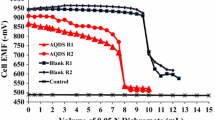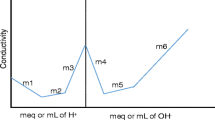Abstract
Purpose
Humic substances (HS) play important functions in the environment by radical scavenging in biogeochemical redox reactions, thus influencing behavior of pollutants and preventing damage to cell membranes; this is due to antioxidant properties of HS. Previous studies focused primarily on assessing endpoint antioxidant capacity (AOC) of HS. Our work aimed to estimate long-term kinetics of the antioxidant capacities of humic and humic-like substances under different pH in relation to their specific structural features.
Materials and methods
The 10-h kinetic profiles of four standard HS and two fungi-produced humic-like substances (HLS) were established with Trolox equivalent antioxidant capacity (TEAC) approach using the ABTS decolorization assay. Three pH levels (3.75, 4.25, and 6.80) and a broad range of humic material concentrations (0.5–10 mg L−1) were examined. The data were divided into intervals and fit using exponential functions to evaluate the endpoint AOCs as well as rate constants for the reaction of humic materials with the ABTS radical cation. To further explore the nature of the antioxidant activities of humic materials, the physicochemical features and antioxidant activities of humic compounds were subjected to correlation analysis.
Results and discussion
Our results demonstrated that during the first 40 min, the determined AOCs did not exceed 50 % of the endpoint AOCs for studies of humic materials, indicating that short-term measures of the AOCs of humic materials provide artificially low values due to the presence of slow-acting antioxidant compounds. Due to the instability of ABTS•+ at neutral and alkaline pH values, only the fast antioxidant moieties of humic materials can be assessed with ABTS decolorization approach under these conditions. Our results show that at acidic pH, the antioxidant activity of HLS is mainly related to the presence of nitrogen-containing groups rather than phenols. However, for HS, both nitrogen-containing compounds and phenolic compounds should be considered.
Conclusions
To obtain clearer information concerning the AOC of humic materials, kinetic profiles should first be established, and then endpoint measurements should be taken at a time when the reaction has reached, or at least neared, the endpoint.



Similar content being viewed by others
References
Aeschbacher M, Graf C, Schwarzenbach RP, Sander M (2012) Antioxidant properties of humic substances. Environ Sci Technol 46:4916–4925
Al-Sehemi AD, Irfan A (2013) Effect of donor and acceptor groups on radical scavenging activity of phenol by density functional theory. Arabian J Chem doi. doi:10.1016/j.arabjc.2013.06.019
Balcke GU, Kulikova NA, Hesse S, Kopinke F-D, Perminova IV, Frimmel FH (2002) The influence of humic substances structure on their adsorption onto kaolin clay. Soil Sci Soc Am J 66:1802–1812
Cano A, Alcaraz O, Arnao MB (2003) Free radical-scavenging acidity of indolic compounds in aqueous and ethanolic extracts. Analyt Bioanalyt Chem 376:33–37
Hotta H, Sakamoto H, Nagano S, Osakai T, Tsujino Y (2001) Unusually large numbers of electrons for the oxidation of polyphenolic antioxidants. Biochim Biophys Acta 1526:159–167
Huang D, Ou B, Prior RL (2005) The chemistry behind antioxidant assays. J Agric Food Chem 53:1841–1856
Illés E, Tombácz E (2006) New method for pH-dependent charge determination of humic acids and its potential use in DOM analysis. In: The 13th Symposium on Analytical and Environmental Problems, Szeged, 25 September 2006, pp 290–293
Karadag A, Ozcelik B, Saner S (2009) Review of methods to determine antioxidant capacities. Food Analyt Methods 2(1):41–60
Koroleva OV, Kulikova NA, Alekseeva TN, Stepanova EV, Davidchik VN, Belyaeva EY, Tsvetkova EA (2007) A comparative characterization of fungal melanin and the humin-like substances synthesized by Cerrena maxima 0275. Appl Biochem Microbiol 43:61–67
Kovalevskii DV, Permin AB, Perminova IV, Petrosyan VS (2000) Recovery of conditions for quantitative measuring the 13C NMR spectra of humic acids. Vestnik Moskovskogo universiteta. Seriya 2 Khimiya 41:39–42 in Russian
Kudryavtsev AV, Perminova IV, Petrosyan VS (2000) Size-exclusion chromatographic descriptors of humic substances. Analyt Chim Acta 407:193–202
Kulikova NA, Stepanova EV, Koroleva OV (2005) Mitigating activity of humic substances: direct influence on biota. In: Perminova IV, Hatfield K, Hertkorn N (eds) Use of humic substances to remediate polluted environments: from theory to practice, NATO Science Series: IV: Earth and Environmental Sciences, Springer, Dordrecht, The Netherlands, 52, pp 285–310
Magalhaes LM, Barreiros L, Maia MA, Reis S, Segundo MA (2012) Rapid assessment of endpoint antioxidant capacity of red wines through microchemical methods using a kinetic matching approach. Talanta 97:473–483
Magalhaes LM, Barreiros L, Reis S, Segundo MA (2014) Kinetic matching approach applied to ABTS assay for high-throughput determination of total antioxidant capacity of food products. J Food Compos Anal 33:187–194
Ortega-Retuerta E, Frazer TK, Duarte CM, Ruiz-Halpern S, Tovar-Sanchez A, Arrieta JM, Reche I (2009) Biogeneration of chromophoric dissolved organic matter by bacteria and krill in the Southern Ocean. Limnol Oceanogr 54(6):1941–1950
Osman AM, Wong KKY, Fernyhough A (2006) ABTS-radical driven oxidation of polyphenols: isolation and structural elucidation of covalent adducts. Biochem Biophys Res Comm 346:321–329
Perminova IV, Frimmel FH, Kudryavtsev AV, Kulikova NA, Abbt-Braun G, Hesse S, Petrosyan VS (2003) Molecular weight characteristics of aquatic, soil, and peat humic substances as determined by size exclusion chromatography and their statistical evaluation. Environ Sci Technol 37:2477–2485
Prior RL, Wu X, Schaich K (2005) Standardized methods for the determination of antioxidant capacity and phenolics in foods and dietary supplements. J Agric Food Chem 53:4290–4302
Rammer DL, Abbott GD (2011) Phenolic compounds in NaOH extracts of UK soils and their contribution to antioxidant capacity. Europ J Soil Sci 62:285–294
Re R, Pellegrini N, Proteggente A, Pannala A, Yang M, Rice-Evans C (1999) Antioxidant activity applying an improved ABTS radical cation decolorization assay. Free Radic Biol Med 26:1231–1237
Reszka KJ, Britigan BE (2007) Doxorubicin inhibits oxidation of 2,2′-azino-bis(3-ethylbenzothiazoline-6-sulfonate) (ABTS) by a lactoperoxidase/H(2)O(2) system by reacting with ABTS-derived radical. Arch Biochem Biophys 466(2):164–170
Romera-Castillo C, Jaffé R (2015) Free radical scavenging (antioxidant activity) of natural dissolved organic matter. Marine Chem 177(4):668–676
Schlichting A, Rammer DL, Eckhardt K-U, Heumann S, Abbott GD, Leinweber P (2013) Identifying potential antioxidant compounds in NaOH extracts of UK soils and vegetation by untargeted mass spectrometric screening. Soil Biol Biochem 58:16–26
Senesi N (1993) Organic pollutant migration in soils as affected by soil organic matter. Molecular and mechanistic aspects. In: Petruzzelli D, Helfferich FG (eds) Migration and fate of pollutants in soils and subsoils, NATO ASI series. Springer-Verlag, Berlin, pp. 32–47
Singleton VL, Rossi J (1965) Colorimetry of total phenolics with phospohmolibdic-phosphotungstic acid reagents. Am J Enol Viticult 16:144–158
Tan DX, Hardeland R, Manchester LC, Poeggeler B, Lopez-Burillo S, Mayo JC, Sainz RM, Reiter RJ (2003) Mechanistic and comparative studies of melatonin and classic antioxidants in terms of their interactions with the ABTS cation radical. J Pineal Res 34(4):249–529
Tarasova AS, Stom DI, Kudryasheva NS (2015) Antioxidant activity of humic substances via bioluminescent monitoring in vitro. Environ Monit Assess 187:89
Walker RB, Everette JD (2009) Comparative reaction rates of various antioxidants with ABTS radical cation. J Agric Food Chem 57:1156–1161
Acknowledgments
Authors express their deepest appreciation to Prof. Irina Perminova (Department of Chemistry, Lomonosov Moscow State University) and her group for providing standard humic substance samples and their physicochemical characteristics. The work was partly supported by the Russian Ministry of Education (GK no. 14.512.11.0067).
Author information
Authors and Affiliations
Corresponding author
Additional information
Responsible editor: Heike Knicker
Electronic supplementary material
ESM 1
(DOC 476 kb)
Rights and permissions
About this article
Cite this article
Klein, O.I., Kulikova, N.A., Filimonov, I.S. et al. Long-term kinetics study and quantitative characterization of the antioxidant capacities of humic and humic-like substances. J Soils Sediments 18, 1355–1364 (2018). https://doi.org/10.1007/s11368-016-1538-7
Received:
Accepted:
Published:
Issue Date:
DOI: https://doi.org/10.1007/s11368-016-1538-7




